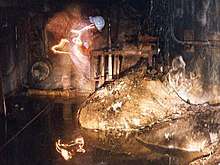Elephant's Foot (Chernobyl)
The Elephant's Foot is the nickname given to a large mass of corium and other materials formed during the Chernobyl disaster in April 1986 and presently located in a steam distribution corridor underneath the remains of the reactor. It was discovered in December 1986. It remains an extremely radioactive object; however, its danger has decreased over time due to the decay of its radioactive components. Unyielding to a drill, the mass is quite dense, but it is able to be damaged by an AKM rifle with armor-piercing rounds.[1][2]

Origin
The Elephant's Foot is a large mass of black corium with many layers, externally resembling tree bark and glass. It was formed during the Chernobyl disaster in April 1986, and discovered in December 1986. It is named for its wrinkly appearance, resembling the foot of an elephant. It lies beneath Reactor No. 4 of the Chernobyl Nuclear Power Plant, under reactor room 217.[3][4]
Composition
The Elephant's Foot is composed primarily of silicon dioxide, with traces of uranium, titanium, zirconium, magnesium and graphite.[1][2][5][6] The mass is largely homogeneous, though the depolymerized silicate glass contains occasional crystalline grains of zircon. These grains of zircon are not elongated, suggesting a moderate crystallization rate. While uranium dioxide dendrites grew quickly at high temperatures within the lava, the zircon began crystallization during slow cooling of the lava. Despite the distribution of uranium-bearing particles not being uniform, the radioactivity of the mass is evenly distributed. The mass is quite dense and unyielding to a drill mounted on a remote-controlled trolley, but able to be damaged by a rifle using armor piercing rounds.[4][1][2] By June 1998, the outer layers had started turning to dust and the mass had started to crack.[7]
Lethality
At the time of its discovery, about 8 months after formation, radioactivity near the Elephant's Foot was approximately 8,000 roentgens, or 80 grays per hour,[2] delivering a 50/50 lethal dose of radiation (4.5 grays)[8] within five minutes.[2] Since that time the radiation intensity has declined enough that, in 1996, the Elephant's Foot was visited by the Deputy Director of the New Confinement Project, Artur Korneyev,[lower-alpha 1] who took photographs using an automatic camera and a flashlight to illuminate the otherwise dark room.[10]
The Elephant's Foot had flowed through at least 2 m (6.6 ft) of pipes and fissures to reach its current location.[4] There were fears that the corium might continue to penetrate deeper into the ground and come into contact with groundwater, contaminating the area's drinking water and leading to illnesses and deaths;[11] however, as of 2016, the mass has not moved significantly since its discovery and is estimated to be only slightly warmer than its environment due to heat from the ongoing nuclear decay.[10]
Notes
- Korneyev was interviewed by The New York Times reporter Henry Fountain in 2014 in Slavutich, Ukraine, before his retirement.[9]
References
- Higginbotham, Adam (2019). Midnight in Chernobyl: The Untold Story of the World's Greatest Nuclear Disaster. Random House. p. 340. ISBN 9781473540828.
The substance proved too hard for a drill mounted on a motorized trolley, ... Finally, a police marksman arrived and shot a fragment of the surface away with a rifle. The sample revealed that the Elephant's Foot was a solidified mass of silicon dioxide, titanium, zirconium, magnesium, and uranium ...
- United States Foreign Broadcast Information Service, ed. (1989). "Daily Report: Soviet Union". No. 235–239. The Service. p. 133.
The radiation level near it was approximately 8,000 roentgens per hour in 1986. Even five minutes spent near the “foot” would have killed a man ... the substance failed to yield to a drill mounted on a special remote-control truck ... A skilled marksman ... fired armor-piercing bullets into it ... Analysis of the fragments obtained in this way showed that they consisted of 70–90% silicon dioxide (fused sand), 2–10% fuel particles, and, in addition, contained graphite (hence the black color), metal alloys, and so on ...
Cite magazine requires|magazine=(help) - Hill, Kyle (4 December 2013). "Chernobyl's Hot Mess, 'the Elephant's Foot', Is Still Lethal". Nautilus. ISSN 2372-1766. Retrieved 8 November 2018.
- R. F. Mould (2000). Chernobyl Record: The Definitive History of the Chernobyl Catastrophe. CRC Press. p. 130. ISBN 9781420034622.
- Jaromir Kolejka, ed. (2002). Role of GIS in Lifting the Cloud Off Chernobyl. NATO Science: Earth and environmental sciences. 10 (illustrated ed.). Springer Science & Business Media. p. 72. ISBN 9781402007682.
- Ann Larabee (2000). Decade of Disaster (illustrated ed.). University of Illinois Press. p. 50. ISBN 9780252068201.
- Vlasova, Irina; Shiryaev, Andrey; Ogorodnikov, Boris; Burakov, Boris; Dolgopolova, Ekaterina; Senin, Roman; Averin, Alexey; Zubavichus, Yan; Kalmykov, Stepan (2015). "Radioactivity distribution in fuel-containing materials (Chernobyl "lava") and aerosols from the Chernobyl "Shelter"". Radiation Measurements. 83: 20–25. doi:10.1016/j.radmeas.2015.06.005. ISSN 1350-4487.
- "Lethal Dose (LD)". US Nuclear Regulatory Commission. 21 March 2019. Retrieved 21 March 2019.
- Fountain, Henry; Daniels, William (27 April 2014). "Chernobyl: Capping a Catastrophe". The New York Times. Retrieved 21 March 2019.
- Goldenberg, Daniel (24 January 2016). "The Famous Photo of Chernobyl's Most Dangerous Radioactive Material Was a Selfie". Atlas Obscura. Retrieved 21 March 2019.
- McVean, Ada (22 Mar 2018). "There is a Radioactive Elephant's Foot Slowly Burning a Hole in the Ground". Office for Science and Society, McGill University. Archived from the original on 7 March 2019. Retrieved 7 March 2019.